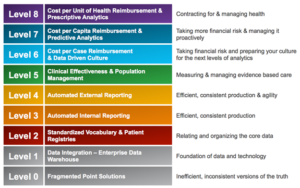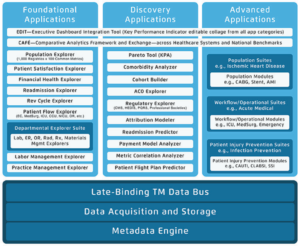
By Jared Crapo, VP, Health Catalyst
Twitter: @HealthCatalyst
I spend a lot of time talking to healthcare organizations about analytics and the practical uses of implementing an analytics adoption model. Oftentimes, though, these discussions turn to other related topics, such as data warehousing, dashboards, natural language processing, Hadoop, population health, meaningful use reporting, predictive modeling, and lots of stuff in between. That’s because people who work in healthcare are interested in finding ways to improve their delivery of care.
But recently, an analytics expert from a health system asked me to describe our approach to analytics adoption as well as how our Analytics Adoption Model would provide value to his health system. Our conversation went something like this.
Setting the Stage with the Healthcare Analytics Adoption Model
To set the stage to answer the analyst’s question, I described the purpose of the Healthcare Analytics Adoption Model, a framework to analytics implementation that borrows lessons learned from the HIMSS EMR Adoption Model. In specific, the Healthcare Analytics Adoption Model provides the following:
- A roadmap for health systems to measure their progress with analytics adoption
- A framework for evaluating vendor’s products
- A framework for evaluating the healthcare industry’s adoption of analytics
 Health Catalyst’s Analytics Adoption Model
Health Catalyst’s Analytics Adoption Model
While the Analytics Adoption Model helps organizations progress to increasingly sophisticated usage of data to inform decision-making, its purpose is to serve as a guidance tool. Health systems also need to adopt two key solutions if they want to become truly data-driven. The two solutions are as follows:
- Late-Binding Enterprise Data Warehouse
A late-binding enterprise data warehouse (EDW) forms the foundation for healthcare analytics. Most large healthcare organizations have hundreds of different technology solutions from various vendors. Without bringing all of this data into a single source of organizational truth, it is impossible for analysts to provide reliable and repeatable reports and analyses. The EDW overcomes these challenges by pulling in all types of data (still in its raw form) from the many different source systems and storing it in one location. After implementing an EDW, organizations can then progress to registries and reporting, population health management, and clinical and financial risk modeling by adopting the use of sophisticated analytics applications. - Analytics Applications
There are many different types of analytics applications, all designed to help health systems solve a certain set of problems. From foundational applications to advanced applications, the analytics products offered by Health Catalyst enable health systems to discover valuable insight and achieve their desired level of analytic adoption as described by the Analytics Adoption Model. More on the various applications below:
Foundational Analytics Applications
Foundational applications automate data distribution and data provisioning — the process of providing users with access to data. These applications put in place an automated, efficient system of reporting and distributing that data internally. They also enable external reporting to programs and organizations, such as the Physician Quality Reporting System (PQRS), Meaningful Use, and the Joint Commission. In addition, they provide dashboards and basic registries for a broad range of clinical and operational conditions. By deploying the complete set of foundational analytics applications, organizations will be able to progress to Level 4 (automated external reporting) of the adoption model.
Discovery Analytics Applications
Discovery analytics applications help hospitals and clinicians pinpoint the areas they should focus on to achieve cost and quality goals. For example, the Key Process Analysis Application shows the cost variation in the treatment of hundreds of different disease conditions. The Cohort Builder Application lets clinicians interactively browse and define specific groups of patients. It also enables them to conduct complex queries — all without the need to be a data expert.
Advanced Analytics Applications
Advanced analytics applications help turn data into action by providing deep insights into evidence-based metrics. Multidisciplinary teams then use these metrics to drive care improvements that result in measurable improvements in quality, outcomes, patient safety, and waste reduction. The advanced applications are grouped into 88 suites, with each suite supporting a care process family, such as heart failure, pregnancy, and cancer.
 Health Catalyst offers a range of analytics solutions from foundational applications to advanced applications.
Health Catalyst offers a range of analytics solutions from foundational applications to advanced applications.
Usefulness of the Analytics Adoption Model to Deliver Evidence-Based Care
The Analytics Adoption Model serves as practical roadmap to help health systems deliver better evidence-based care for their patients. By following the Adoption Model and adopting a Late-Binding™ Data Warehouse and sophisticated analytics solutions, healthcare organizations can confidently deliver evidence-based care for a population of patients, as described by Level 5 of the adoption model. Then as providers become more confident about making data-driven decisions, they’ll be able to progress to higher levels of the Adoption Model. Once at these higher levels, they’ll be able to manage episodes of care by using predictive modeling, forecasting, and risk stratification to support outreach, triage, escalation, and referrals. With these capabilities, health systems will be able to achieve the ultimate goal that has eluded most provider organizations — that of improving the quality of care while lowering costs and enhancing clinician and patient satisfaction. I sure hope you will find the Adoption Model useful as you evaluate your organizational analytic goals and your plans to achieve those goals.
About the Author: Jared Crapo joined Health Catalyst in February 2013 as a Vice President. Prior to coming to Catalyst, he worked for Medicity as the Chief of Staff to the CEO. During his tenure at Medicity, he was also the Director of Product Management and the Director of Product Strategy. Jared co-founded Allviant, a spin-out of Medicity, that created consumer health management tools. In his early career, he developed physician accounting systems and health claims payment systems. This article was originally published on Health Catalyst and is republished here with permission.
